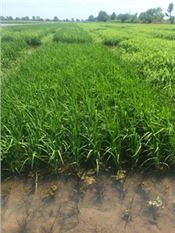|
Hot, Dry Weather Leaves Arkansas Rice Producers With Tough-To-Fight Weeds In Fields

Test rice plot showing Command pre-emerge followed by Obey at 2 to 3 leaf stage, followed by Loyant pre-flood.
U of A System Division of Agriculture photo by Tom Barber
LITTLE ROCK, ARK.
Rough weather conditions caused many Arkansas rice fields to be overrun with grassy weeds.
Tom Barber, extension weed scientist for the University of Arkansas System Division of Agriculture, said unusual rainfall pattern made this season a rough one for many Arkansas crops.
“This is the grassiest rice crop we’ve seen in a while, but it’s also been a difficult year for many crops,” Barber said. “We had a lot of rain early, and then by May it shut off and we stayed dry and temperatures increased. We basically got typical June weather in May.”
Barnyardgrass has a reputation for being difficult to manage in rice. This is why extension specialists recommend overlaying residual herbicides, meaning applying an herbicide at planting, and then another at early post-emergence from spiking to two-leaf rice.
“With barnyardgrass populations, our recommendations have been to overlay residual herbicides,” Barber said, “because once it comes up, many or our barnyardgrass populations are difficult to manage.”
Although this method is a handy go-to, Arkansas missed the much needed rainfall during a critical time for herbicide activation and, due to thin profit margins and time constraints, were hesitant to flush.
“Residual herbicides require rainfall for activation,” Barber said, “and since we didn’t get it, we had grass come up with the rice because many growers didn’t flush.”
Barber said if growers can’t get a handle on barnyardgrass before their rice emerges, management becomes increasingly difficult.
“When the grass comes up with the rice, we usually will spend a lot of time and money trying to control it,” Barber said, “but it was much more difficult to kill this year due to hot and dry conditions.”
Lack of rainfall wasn’t the only obstacle rice producers faced this year.
“And our products didn’t work as well as we hoped,” Barber said. “So, once the fertilizer was applied and fields flooded, the grass shot up and there wasn’t any stopping it after that.”
Although some growers were able to take preventative measures, others seem to be out of luck.
“The growers that did flush, applied a residual herbicide, and then flushed again have the best crop,” Barber said. “But if we have barnyardgrass now, we’re going to have to live with it. We have spent a lot of money on revenge applications, but it likely won’t kill it.”
All is not lost, though. Many Arkansas rice fields have only small amounts of barnyardgrass, which causes minimal damage. But those with more are facing a bigger problem.
“The No. 1 problem is that grassy rice can reduce yield,” Barber said. “If it’s patches of barnyardgrass, it isn’t as much of a factor. But if the grass is widespread, it’s a problem.”
Widespread grass weeds can have big implications come harvest time and cause lodging, meaning the rice bends or falls over.
“If the grass is widespread, it can cause severe lodging, which can reduce quality and harvest efficiency. It’s just a negative scenario all the way around,” Barber said. “So the biggest negative aside from yield loss is lodging.”
Although weather plays the biggest role in this, there are recommendations to help farmers prevent future heartache.
“Obviously the weather has a big role in this. We normally get more frequent rainfall early spring than we’ve had this year,” Barber said. “But we also recommend crop rotation. Fields that have been continuous rice for many years really need to be rotated with soybean. This allows us to use group 15 herbicides such as Dual or Zidua to help control barnyardgrass populations and reduce the seedbank. You’re able to use more chemistry when working in soybeans, so you really need to rotate to soybeans for two years if possible to get a handle on tough barnyardgrass populations.”
Barber recommends this crop rotation paired with sensible herbicide applications.
“Barnyardgrass control has been difficult in our plots as well this year, but the best looking ones contained multiple residuals up front such as Command plus Facet followed by Prowl plus Bolero or Command followed by Command plus Facet (Obey) followed by a post-emergence product plus Prowl,” Barber said. “Similar to pigweed control in soybeans, we need to lay a good foundation of residuals to reduce the overall barnyardgrass populations to manageable levels by pre-flood timings.
“In addition we have had some field experience with Provisia rice this year and, for the most part, Provisia has been able to clean up the barnyardgrass and red rice in our problem fields,” Barber added.
Commercial product names mentioned do not imply endorsement by the University of Arkansas System Division of Agriculture. ∆
|
|